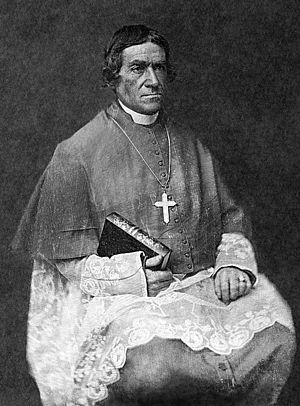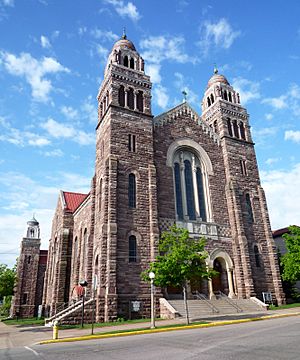Frederic Baraga facts for kids
Quick facts for kids Venerable Frederic Baraga |
|
|---|---|
| Bishop of Sault Sainte Marie and Marquette | |

Baraga in episcopal choir dress, holding his Dictionary of the Otchipwe Language,
in a photograph taken by Mathew Brady (ca. 1853–1860) |
|
| Native name | Irenaeus Fridericus Paraga |
| Province | Detroit |
| See | Sault Sainte Marie, later Sault Sainte Marie and Marquette |
| Appointed | January 9, 1857 |
| Reign ended | January 19, 1868 |
| Successor | Ignatius Mrak |
| Orders | |
| Ordination | September 21, 1823 |
| Consecration | November 1, 1853 by John Baptist Purcell |
| Personal details | |
| Birth name | Friderik Irenej Baraga |
| Born | June 29, 1797 Mala Vas, Duchy of Carniola, Habsburg monarchy, (today Slovenia) |
| Died | January 19, 1868 (aged 70) Marquette, Michigan, United States |
| Buried | St. Peter Cathedral, Marquette, Michigan, United States |
| Nationality | Habsburg monarchy |
| Denomination | Roman Catholic |
| Previous post |
|
| Alma mater | University of Vienna |
| Coat of arms |  |
| Sainthood | |
| Venerated in | Roman Catholic Church |
| Title as Saint | Venerable |
Frederic Baraga (born June 29, 1797 – died January 19, 1868) was a Slovenian Catholic missionary who came to the United States. He was also a grammarian and wrote Christian poetry and hymns in Native American languages. He became the very first bishop of the Roman Catholic Diocese of Marquette, Michigan. He led this area for 15 years.
His letters about his missionary work were shared widely in Europe. These letters inspired other priests, like John Neumann and Francis Xavier Pierz, to come to the United States. In 2012, Pope Benedict XVI declared Baraga "Venerable." This means he is recognized for his holy life and good deeds.
Frederic Baraga's Early Life
Frederic Baraga was born in a large house in Mala Vas, a village in what is now Slovenia. He was the fourth of five children. His parents were Janez Baraga and Marija Katarina Jožefa. Frederic's mother inherited land and money. Sadly, both his parents died when he was young. His mother passed away in 1808, and his father in 1812. Frederic then lived with Jurij Dolinar, a teacher in Ljubljana.
Baraga grew up during the Napoleonic Wars. During this time, the official language in his schools changed often between Slovenian and German. By the time he was nine, he could also speak French. Latin and Greek were also required subjects. This meant that by age 16, Frederic Baraga could speak many languages. This skill helped him greatly later in life.
Becoming a Priest
Baraga studied law at the University of Vienna. He finished his studies in 1821. After this, he decided to become a priest and entered the seminary in Ljubljana. On September 21, 1823, at age 26, he became a Roman Catholic priest. He was ordained in the St. Nicholas' Cathedral. As a young priest, he worked in different towns in Slovenia. He also wrote a spiritual book in Slovene.
In 1830, Bishop Edward Fenwick of Cincinnati asked for priests to help with his growing church. This included a large mission area. Baraga left his home on October 29, 1830. He arrived in New York on December 31 and in Cincinnati, Ohio, on January 18, 1831. He first worked with German immigrants. At the same time, he began to learn the Ottawa language. In May 1831, he went to the Ottawa Indian mission at L'Arbre Croche (now Cross Village, Michigan) to become fluent in the language.

In 1837, he published his first book written in the Ottawa language. It was called Otawa Anamie-Misinaigan. This book included a Catholic catechism (a book of religious teachings) and a prayer book. After a short time at a mission in Grand Rapids, Michigan, Baraga moved north in 1835. He went to serve the Ojibway (Chippewa) Indians at La Pointe, Wisconsin, on Lake Superior. This was a former Jesuit mission.
In 1843, Baraga started a new mission at L'Anse, Michigan. During this time, he became known as "the Snowshoe Priest." This was because he would travel hundreds of miles each year on snowshoes during the cold winters. He worked hard to protect the Native Americans from being forced to move from their lands. He also published a dictionary and a grammar book for the Ojibway language. These books are important for history.
With help from many native speakers, Father Baraga also wrote about 100 Catholic hymns in the Ojibwe language. These were published in a hymnal (a book of hymns). The Ojibwe people still use these hymns in Catholic worship in both Canada and the United States today.
Through the books and texts Baraga published, people in Slovenia learned about Native American culture and the United States.
Becoming a Bishop
Baraga was made a bishop by Pope Pius IX. He was consecrated (officially made a bishop) on November 1, 1853, in Cincinnati. He became the first bishop of the Roman Catholic Diocese of Sault Sainte Marie, Michigan. This area is now called the Diocese of Marquette.
Starting July 27, 1852, he kept a diary. He wrote in several languages, including German, English, French, Slovene, and Ojibway. In his diary, he wrote about his missionary travels. During this time, many European immigrants came to the area. They came to work in the copper and iron mines near Houghton, Ontonagon, and Marquette. This was a challenge for Baraga. He had few priests to help both the immigrant miners and the Native Americans. More people and development led to better transportation on Lake Superior.
The only way to travel in winter was on snowshoes. Baraga continued to do this even when he was in his sixties. He faced challenges because of the many different groups of people in the region. These included Native Americans, French-Canadian settlers, and new German and Irish immigrant miners. It was hard to find priests who could speak all these different languages. Baraga himself spoke eight languages fluently.
Baraga traveled to Europe twice to raise money for his diocese. The Emperor Franz Joseph I of Austria gave him a special jeweled cross and bishop's ring. Baraga later sold these valuable items to help fund his missions.
Baraga wrote many letters to the Society for the Propagation of the Faith. In these letters, he described his missionary work. The Society published his letters widely. They were used as examples of missions in North America. These letters helped inspire priests like John Neumann and Francis Xavier Pierz to come to the United States. Over time, Baraga became famous across Europe for his work. In his last ten years, his health slowly got worse. He became deaf at times and had several strokes. He passed away on January 19, 1868, in Marquette, Michigan. He is buried there in the crypt under the Cathedral of Saint Peter.
Legacy and Recognition

Frederic Baraga was declared venerable by Pope Benedict XVI on May 10, 2012. The process to make him a saint began in 1952. The diocese planned to move his remains to a new chapel in the cathedral. This would make it easier for people to visit and honor him. At the time he was declared Venerable, the Vatican was looking into a possible miracle connected to him. This is a step towards becoming a saint.
Many places are named after him:
- The village of Baraga, Baraga Township, Baraga County, and Baraga State Park (all in Michigan) are named for him.
- The Diocese of Ljubljana started building the Baraga Seminary in Ljubljana in 1936.
- A street in Milwaukee is named for Baraga.
- A special plaque is located at Our Lady of Sorrows Roman Catholic Church in Goulais Bay, Ontario. Baraga built this church.
- A memorial sculpture of him is in L'Anse, Michigan.
- Bishop Baraga Catholic School in Iron Mountain, Michigan and in Cheboygan, Michigan are named for him.
- In 1846, Baraga put up a wooden cross in Schroeder, Minnesota. This was at the mouth of the Cross River. He did this to thank God for his safe landing during a storm on Lake Superior. A granite cross has replaced it.
- At the Shrine of Our Lady of Guadalupe in La Crosse, Wisconsin, a shrine in the church honors him.
- A bronze statue of Baraga in Grand Rapids honors his work. He established the first Catholic mission there in 1833.
- Baraga is the namesake of a group of six Catholic radio stations in northern Michigan.
- The U.S. Postal Service issued a postcard honoring Baraga in 1984.

